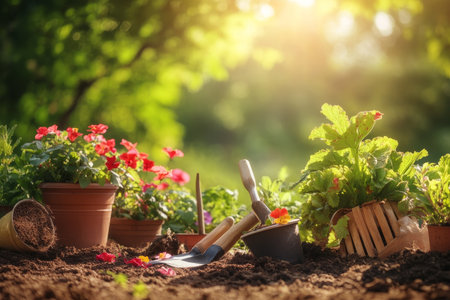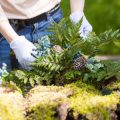Understanding Aphids and Their Impact
Aphids, those tiny, pear-shaped insects, are a common sight in American home gardens. While their delicate appearance may seem harmless at first glance, these soft-bodied pests can quickly disrupt the harmony of your outdoor sanctuary. Aphids feed on plant sap, piercing tender stems and leaves with their slender mouthparts. This feeding habit not only weakens plants but also causes distorted growth, yellowing foliage, and the unsightly curling of leaves. Moreover, aphids excrete a sticky substance called honeydew, which attracts ants and encourages the growth of sooty mold—a black fungus that further mars the beauty of your landscape.
Early detection of aphid infestations is vital for maintaining a flourishing garden. In the diverse climates and unique plant palettes found across American yards—from lush backyard vegetable patches to vibrant native wildflower beds—aphids can rapidly multiply under favorable conditions. By learning to recognize the subtle signs of their presence, such as clusters on new shoots or shimmering trails of honeydew, home gardeners can act swiftly to protect their cherished green spaces. Addressing aphid problems in their infancy not only preserves the visual appeal of your garden but also minimizes the need for harsh chemical interventions, keeping your outdoor retreat a safe haven for pollinators and people alike.
2. Inviting Beneficial Insects
Creating a balanced backyard ecosystem is one of the most beautiful and effective ways to naturally control aphid populations. By inviting beneficial insects such as ladybugs and lacewings, American home gardeners can nurture an environment where nature does much of the pest control for you. These natural predators not only keep aphids in check but also add vibrant life and motion to your garden landscape.
How to Attract Natural Predators
Ladybugs, lacewings, and other helpful insects are drawn to gardens that offer food, shelter, and diversity. Incorporate a variety of native flowering plants, shrubs, and grasses to provide nectar and pollen throughout the growing season. Avoid using broad-spectrum pesticides, which can harm these allies. Instead, focus on creating habitats that support their lifecycle.
Plant Choices That Attract Beneficials
| Beneficial Insect | Favorite Plants |
|---|---|
| Ladybugs | Dill, fennel, yarrow, marigold |
| Lacewings | Coriander, cosmos, sweet alyssum |
| Hoverflies | Buckwheat, asters, sunflowers |
Garden Tips for Success
- Mix annuals and perennials for continuous blooms
- Leave some areas slightly untidy for insect shelter
- Provide shallow water sources like birdbaths or pebbled trays
This harmonious approach not only helps manage aphids but also brings a sense of wild beauty and ecological balance to your American home garden. By working with nature instead of against it, you’ll cultivate a thriving space that’s both resilient and visually stunning.

3. Homemade and Organic Solutions
When it comes to managing aphids in your American home garden, gentle homemade remedies are both effective and environmentally friendly. Many of these solutions rely on simple ingredients you likely already have in your kitchen or pantry, making them accessible and budget-conscious options for any gardener.
Soap and Water Spray
One of the most trusted methods is a basic soap and water spray. Mix a few drops of mild liquid dish soap—preferably unscented and biodegradable—with a quart of water. Pour the mixture into a spray bottle, shake gently, and mist directly onto affected leaves. The soap disrupts the aphids’ protective outer layer, helping to remove them without harming your plants or beneficial insects.
Neem Oil Blend
Neem oil, derived from the neem tree, is a favorite among organic gardeners across America. It not only deters aphids but also interrupts their reproductive cycle. Combine one teaspoon of pure neem oil with a quart of water and a few drops of dish soap to help the oil disperse evenly. Spray this blend on your plants every few days until the infestation subsides.
Garlic and Pepper Sprays
Harnessing the natural pungency of garlic or hot peppers can also keep aphids at bay. To make a garlic spray, crush several cloves and steep them in water overnight; strain before spraying onto plants. For a pepper solution, blend hot peppers with water, strain thoroughly, and apply as needed—just be sure to wear gloves when handling spicy mixtures!
Additional Garden Wisdom
Aphids dislike strong scents like mint or citrus. Placing orange peels around your garden beds or growing aromatic herbs such as basil and chives can create an inviting yet protective landscape for your flowers and veggies. These approaches not only nurture your plants but also celebrate the creativity and resourcefulness cherished by American home gardeners.
4. Smart Plant Choices and Companion Planting
When it comes to sustainable aphid management, thoughtful plant selection can make all the difference. Many American gardeners overlook the power of using native or widely grown plants that naturally repel aphids, while also leveraging the time-honored practice of companion planting. By curating a garden with strategic plant partnerships, you not only discourage aphids but also create a more resilient and harmonious landscape.
Choosing Aphid-Resistant Plants
Some plants commonly found in American gardens are naturally unappealing to aphids. Incorporating these species helps reduce aphid populations without resorting to chemicals. For instance, aromatic herbs such as rosemary, sage, and catnip emit scents that ward off these pests. Native wildflowers like yarrow and milkweed not only deter aphids but also attract beneficial insects such as ladybugs and lacewings—the natural predators of aphids.
Popular Aphid-Deterring Plants in America
| Plant Name | Type | Aphid-Repelling Property |
|---|---|---|
| Catnip (Nepeta cataria) | Herb | Strong scent repels aphids |
| Marigold (Tagetes spp.) | Flower | Roots release substances toxic to pests |
| Garlic (Allium sativum) | Vegetable/Herb | Pungent aroma deters many insects |
| Sage (Salvia officinalis) | Herb | Aromatic oils discourage aphids |
| Yarrow (Achillea millefolium) | Native Wildflower | Attracts predatory insects; disliked by aphids |
The Art of Companion Planting for Resilient Gardens
Companion planting is both an art and a science, rooted in centuries of gardening wisdom. It involves pairing plants that benefit each other—either by improving growth, offering shade, or repelling pests like aphids. For example, planting garlic or chives near roses can help keep aphid numbers down on your prized blooms. Similarly, interspersing vegetables with basil or nasturtiums forms a living barrier against infestations.
Favorite Companion Combinations for American Home Gardens:
- Tomatoes + Basil: Basil improves tomato flavor and keeps aphids at bay.
- Cabbage Family + Marigolds: Marigolds repel aphids from cabbage, broccoli, and kale.
- Roses + Garlic: Garlic’s scent confuses and deters aphids attacking roses.
- Lettuce + Chives: Chives’ aroma discourages aphids from settling on leafy greens.
This mindful approach to garden planning not only reduces chemical reliance but celebrates the unique palette of American plants. With each purposeful pairing, you’re nurturing a living tapestry that is as beautiful as it is resilient—offering sanctuary for pollinators and keeping your green spaces vibrant all season long.
5. Mindful Watering and Garden Maintenance
When it comes to protecting your garden from aphids, the way you water and maintain your landscape can make all the difference. Thoughtful irrigation habits help keep your plants resilient, while regular garden upkeep creates an environment less inviting to pests.
Watering Wisely for Stronger Plants
Aphids are quick to exploit stressed or weakened plants. In many American gardens, overwatering or underwatering is a common pitfall. Instead, aim for deep, infrequent watering that encourages strong root systems—consider using soaker hoses or drip irrigation to target roots directly and reduce moisture on leaves, which can attract aphids and other pests.
Pruning: Your Garden’s Preventative Care
Routine pruning isn’t just about aesthetics; it’s about plant health. By removing dead or overcrowded branches, you improve airflow and sunlight penetration, making it harder for aphids to hide and multiply. Focus on cutting back any infested stems immediately and disposing of them away from your compost pile to prevent reinfestation.
Weeding and Mulching for Pest Control
Keep your beds tidy by pulling weeds regularly—they can harbor aphid colonies and compete with your ornamentals for nutrients. Mulch thoughtfully using organic materials like shredded bark or straw; this helps retain soil moisture while creating a less hospitable surface for aphids to travel across.
The Benefits of Routine Observation
Spend a few moments each week strolling through your garden spaces. Watch for early signs of aphid activity, such as curled leaves or sticky residue (honeydew). Catching infestations early lets you act quickly with natural solutions before the problem escalates.
By cultivating mindful watering practices and keeping up with regular maintenance tasks, American gardeners create healthy, thriving landscapes that naturally resist aphid invasions—fostering both beauty and balance in every backyard haven.
6. When to Take Further Action
Even the most attentive home gardeners can sometimes find themselves facing an aphid population that seems to multiply overnight. Knowing when a natural approach is enough—and when it’s time to seek extra help—is key to keeping your garden healthy and thriving.
Assessing the Severity of Aphid Infestations
Start by inspecting your plants regularly. A few aphids here and there can often be managed with simple remedies, but if you notice large clusters on stems and undersides of leaves, or see significant leaf curling, yellowing, or stunted growth, it’s time for a more strategic response. Watch for sticky residue (honeydew) and increased presence of ants—both are signs that the infestation is escalating.
Evaluating Your Options
If your initial natural methods—like encouraging beneficial insects or using gentle sprays—aren’t keeping the aphids in check, don’t worry. This is a common challenge, especially during peak growing seasons across America’s varied climates. Keep records of what you’ve tried and note which plants are being affected most.
When to Consult Local Experts
If the infestation persists or spreads rapidly despite your efforts, reach out to your local garden center or cooperative extension office. These community resources offer region-specific advice that takes into account local plant varieties, climate, and the types of aphids common in your area. Staffed by experienced gardeners and horticulturists, they can recommend integrated pest management solutions tailored to American gardens, ensuring you protect both your landscape and the pollinators who call it home.
Remember, every garden faces its battles. By staying observant and knowing when to seek help, you’re building not just a beautiful landscape—but a resilient one as well.

